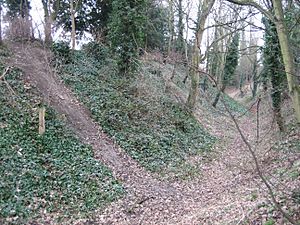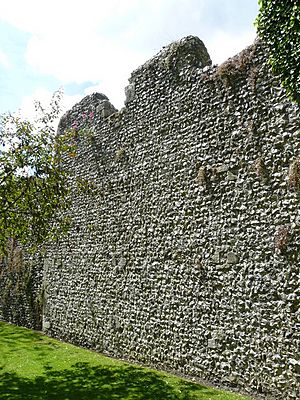Burh facts for kids
Imagine a strong, fortified town built long ago in England! That's what a burh (pronounced "bur-uh") or burg was during the time of the Anglo-Saxons. These special towns were built to protect people from fierce Viking raiders in the 9th century.
Alfred the Great was a very smart king. He created a whole network of these burhs and roads to fight back against the Vikings. Some burhs were brand new, while others were built on older forts from the Iron Age or Roman times. Many burhs were placed near rivers, like old London (called Lundenburh back then). This helped bring supplies in and made it harder for Viking ships to sail deeper into the country.
Besides being strong forts, burhs were also busy places for trade and government. They even protected the places where coins were made for the king!
Contents
What's in a Name?
The words Burh and burg come from a very old language called Proto-Germanic. They are related to words in other languages like German (Burg) and Dutch (burcht). In English, these words eventually turned into "borough" (like a town or district) and "burgh" (especially in Scotland).
The word Byrig was the plural form of burh, meaning "forts" or "fortifications." It also meant "to the fort" or "for the fort." This word later became "bury" or "berry," which you can still see in some place names today, often describing old settlements or large farms near a fort.
Why Were Burhs Built?

Burhs were first built as military defenses. They were a really important step in how medieval English towns developed. You can often still see the old boundaries of burhs in modern towns today!
Most of these burhs were started by Alfred the Great as part of a careful plan. His son, Edward the Elder, and his daughter, Æthelflæd (the 'Lady of the Mercians'), continued this work. Æthelflæd built ten burhs, some as important as Tamworth and Stafford.
Some burhs were built on top of old Roman structures, while others were brand new. Later, Æthelstan gave these burhs the right to make coins. For a long time, no coins could be made anywhere outside a burh.
A document from the 10th century, called the Burghal Hidage, lists thirty burhs in Wessex and three in Mercia. All these burhs were built to protect the area from Viking raids.
Only a few of these burhs grew into major towns in the Middle Ages, like Chester and Warwick. The biggest burhs were at Winchester, Wallingford, and Warwick. Wallingford and Wareham are great examples because you can still see their old ditches and banks. Building Wallingford's huge bank would have taken over 120,000 hours of work! Burh towns often had a planned street layout, which you can still see in some places today. Many historians believe burhs were the start of urban life in England.
How Were Burhs Built?
Burhs were built in different ways, depending on what materials were available and how big the settlement was.
- Using Old Forts: Sometimes, old Roman walls were simply repaired, like in towns such as Winchester and Exeter. Other times, builders used old Iron Age forts, taking advantage of their existing ditches and ramparts.
- Building New Towns: Many burhs were completely new forts built in smart locations, like on the coast, near ports, or overlooking important roads. Large new towns were built on flat land with a rectangular shape, such as Oxford and Wallingford.
Typically, burhs were built with a huge series of banks and a ditch in front. The bank was often made of timber and reinforced with wood. On top of this, there was a wooden fence (palisade) up to 10 feet high, with a walkway for defenders. Over time, these wooden defenses would wear down. To make them stronger and last longer, the banks were sometimes faced with stone, like at Tamworth.
The Purpose of Burhs
The main goal of burhs was to protect a port or town, along with the farms and villages around it. According to the Anglo-Saxon Chronicle, Alfred built over 30 burhs, as listed in the Burghal Hidage. It seems Alfred wanted every English farm or village to be no more than 20 miles away from a burh.
He also built a network of well-kept army roads, called herepaths. These roads connected the burhs, allowing people to quickly reach safety in their local burh. The herepaths also helped Alfred's soldiers move quickly to fight the enemy. This meant that extra troops could be called in easily from other burhs if needed. Some historians believe each burh might have had a group of mounted soldiers ready to fight the Vikings. There were probably also signal beacons on high hills to give early warning of invaders. With this clever system of forts and defenses, Alfred made it very hard for the Vikings to capture important towns and ports.
Burhs also had other important jobs as economic centers. They were safe places where trade and production could happen. Places for making weapons, blacksmiths, royal mints (where coins were made), and trading posts were all located inside the burh. They also served as supply depots for the Saxon army, making sure soldiers always had weapons, fresh horses, and food.
During Alfred's time, there was a clear difference between the king's army (the royal fyrd) and the local defense force (the local fyrd). The local fyrd was in charge of building and defending their burh, while the royal fyrd served directly under the king.
See also






